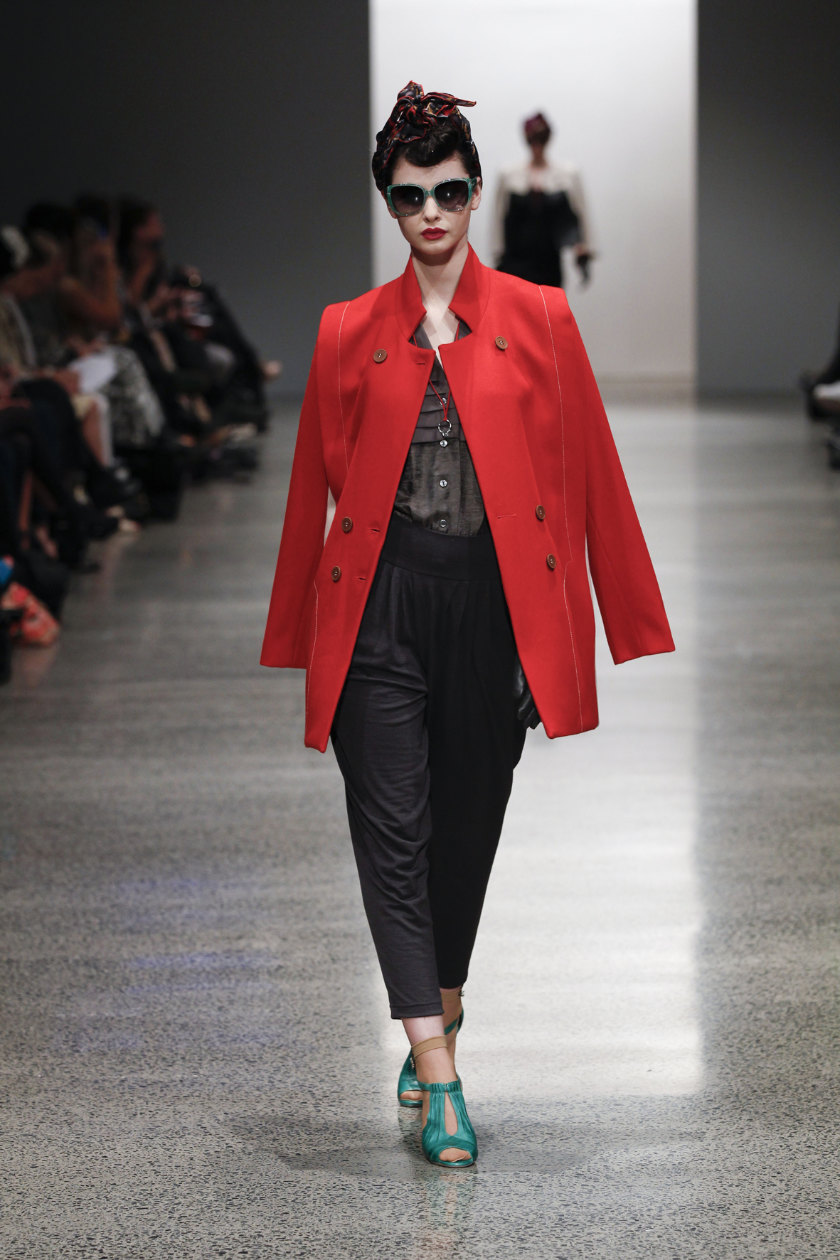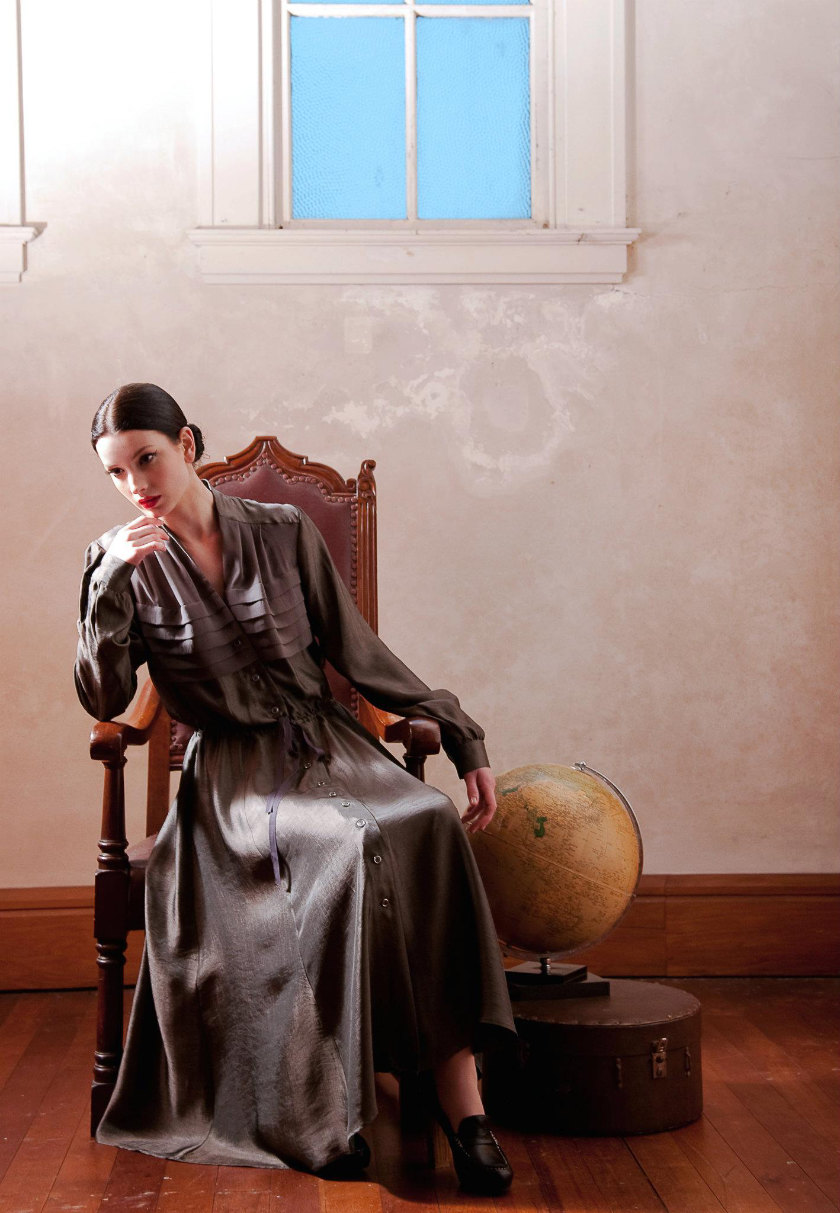
Above: From Deryn Schmidt’s spring–summer 2021–2 collection, her Custom blazer and Optimism pant, both in cotton.
FASHION Her designs may exhibit boldness and quality, but designer Deryn Schmidt is not one to shout from the rooftops. Instead, she has a modest approach to her work, recognized by those truly in the know when it comes to properly tailored, well finished fashion, writes Jack Yan
First published in the December 2021 issue of Lucire KSA

Above: A relaxed look for winter 2021.

Michael Ng



Imagination through the 2010s: At New Zealand Fashion Week, September 2011. From Deryn Schmidt’s Around in Circles collection, spring–summer 2011–12. Celebration dress, autumn–winter 2012. From the Into the Unknown collection, autumn–winter 2015.
Wellington, New Zealand-based designer Deryn Schmidt has been on Lucire’s radar since she started up her eponymous label in spring 2010. That first collection had already made an impact on fashion and beauty editor Sopheak Seng, who keenly followed each of her collections. By 2011 he featured her spring–summer 2011–12 collection with its own story, and looking at her designs a decade on, they still look fresh, feminine, and optimistic.
Yet the story and philosophy behind this very private designer has seldom been told, from her origins in Dannevirke, a rural town of just over 5,000 people, to her working in London, and launching her label in the midst of a recession.
Schmidt’s initial interest was nurtured by her seamstress grandmother, who taught her to sew at a young age. She recalls, ‘From as long as I can remember, I would be at my Nana’s doing all sorts of projects. Whatever we could find and think up next, we would dig it out of her cupboards. Every drawer and cupboard at Nana’s in all three bedrooms were filled with fabric, craft stuff, patterns—you name it, she had it—and she knew exactly where everything was. Nothing went to waste. So the skill of dressmaking and craft had to be ingrained in one of six grandkids and that one was me.’
She continued to hone her craft at high school, and says she didn’t enjoy her classes, with the exception of clothing tech.
By the time she was 15, she had won a Manawatu regional design award for her design and marketing, and the follow year, she took out the top prize in the same competition. But despite these early successes, Schmidt has a surprising admission. ‘I never dreamed of being a fashion designer. It was more about the whole process and still is. I love the skill of pattern-making and pushing the boundaries and getting the fit absolutely perfect.
‘I did, however, dream I would be in the fashion industry working for leading fashion designers which I did achieve.
‘I find it hard to say I’m a fashion designer because I am much more than a designer. Owning the company means I put my hand to everything I can. One, to make sure it’s right and, two, to keep costs down.’
That includes cutting everything herself in-store, with the exception of her heavy coats, which are done by Stirling Cutting in Auckland.
Those skills were acquired when Schmidt headed to Wanganui Polytechnic School of Design for her degree just as she turned 17. She had left home ‘very young’, and embarked on her three-year course in design and textiles at Wanganui after having been turned down by Wellington Polytechnic (now Massey University) due to her age. The decision, she says, had been made for her.
‘I had the best years at WP. It was a great place to be a student and I was also lucky enough to be in the years when Sue Prescott and Iain Archer were teachers there, along with skilled sewing teachers.’ Schmidt had the two well respected educators for her three years, and Prescott later wound up heading the fashion department at Massey.
Each weekend she immersed herself even more, taking on a job at Bryan Gaskin Fabrics in Palmerston North that had been offered to her by one of the competition judges. That added to her knowledge, including listening to customers and learning about their preferences.
Her first job after graduation was with Robyn Mathieson in Wellington, starting out finishing garments, and worked up to pattern-cutting and cutting. Schmidt believes understanding pattern-cutting is imperative to designing, as it is integral to how the garment will look and appear on the body.
Soon after, she headed to London, where her pattern-cutting skills kept her in good stead, with a tough taskmaster as her immediate superior. Having gained more experience there, Schmidt headed to Karen Millen.
‘I always had in the back of my mind to get as much experience in the industry as I could working for designers I admired. They definitely helped me learn and understand what to do and not to do as a designer and business. Having a different role at every company helped me understand all aspects,’ she says.
‘Working at Karen Millen London head office was an eye-opener to international companies. Inside knowledge of how the industry works on a large scale definitely shaped my outlook. Travelling for work to Lithuania and visiting huge factories was another huge eye-opener. I was still only 25 years old.’
At Karen Millen, it was also Schmidt’s job to seal a garment for production, which she called a valuable experience. It is the last job in the process, where she would be given a sample, from which she had to create the spec sheet for the manufacturers to follow.
‘It would be my boss, the pattern-cutter and myself inspecting the garment on the model before approving and sending it to production for hundreds, sometimes thousands, to be made. Sometimes I would send it back two or three times before approving the garment. This made me extremely precise and fussy which I think has come through in my own work.’
She calls the Karen Millen brand ‘beautiful’, and that her style was ‘classic with exquisite detail.’
With her and her partner Carl Fenemor’s visas running out, the couple returned to New Zealand in 2005, where Schmidt worked as a production assistant for Helen Cherry in Auckland, before taking up the role of production manager with Andrea Moore in Wellington.
The Deryn Schmidt label was almost born out of necessity after her five years working for the two New Zealand labels. ‘I then settled in Wellington, bought a house, and had our first baby. While I was on maternity leave, Andrea had decided to move her business to Auckland and, unfortunately, I wasn’t keen to move back so I became redundant. My daughter Millicent was six months old at the time and it was the start of the GFC [global financial crisis]. Three months later Carl was made redundant, so we decided between us, “What better time to do something for ourselves?”
‘We applied for a government grant and were successful, which gave us funds for the first range and hit the road selling. So we sort of just put it down to fate … Also working from our garage made sense with a newborn baby. Carl became Millie’s main carer and worked on everything else to do with marketing, sales, spreadsheets, accounts, website, ordering etc. While I did the rest.’
In the beginning, the couple had their workroom in their Porirua home—minutes from Lucire’s HQ—where the garage housed the sewing machine and cloth.
Eight stores recognized Schmidt’s quality, agreeing to stock her label, and things quickly grew from there.
With hindsight, it’s apparent why: here is a local label made to international standards, with fine tailoring and undeniable appeal, which Schmidt has kept up from season to season.
‘I am always flicking through Paris haute couture, Iconic Dresses by William Banks-Blaney, Alexander McQueen, Yves Saint Laurent, Dior for inspiration, but staying true to what I would wear and feel comfortable in is where it always comes back to,’ she explains.
And the secret to her consistently high quality? For starters, she chooses natural materials, which are ‘breathable and environmentally friendly,’ she says.
‘The cost for natural fabrics is significantly higher than synthetics, but the benefits outweigh the costs, so it’s a no-brainer for me.
‘Sometimes I am drawn to the colours and print of a polyester but refuse to purchase without a second thought.’
The price rises for quality merino, wool and silk have placed more pressure on her costs, but Schmidt remains steadfast.
‘I don’t compromise on fabric quality. I have always said no to polyester, nylon, etc. Testing fabrics for seam slippage is so important, and washing shrink tests, etc.; everything adds to the quality of the garment.
continued



Above, from top:
Realism shirt, spring–summer 2016–17.
Leather jacket, 2019.
Staying cool for spring–summer 2018–19.
Schmidt also puts the quality down to a team effort. ‘I have also had the same machinists the whole time: they also know what standard I expect and take their time to get it right the first time. I have a huge respect for my contractors because without them I couldn’t do what I do.’ As a result she sees them as ‘family’ and they are paid well.
She had said early on, ‘I would close my doors before resorting to made in China,’ a promise she has kept. ‘I believe strongly about keeping our industry alive here in New Zealand and even over the last 10 years, we have seen a decline. It is frightening to think of what the industry will be in another 10.
‘If we don’t support it, it won’t be here to support. We only realize things like this when it’s too late.’
Her inspirations have varied considerably over the last 12 years, including the 1940s and techno driving collections. It’s something she has enjoyed as part of her creative process. ‘I have loved exploring all styles and dabbling in different eras. Getting inspiration by flicking through my Nana’s patterns was always a great way to find ideas. She lived 95 years, so she had all eras. It all just comes back around and if you love it when it does, then go for it,’ she explains.
There is a Deryn Schmidt staple of the classically tailored jacket and wide or straight leg pants. ‘I remember my mum had a mint green suit in the ’70s which she would always bring out to show me—maybe somehow this has stuck with me.’
Starting the business during a financial crisis has certainly helped Schmidt remain careful as she steered her label over the past decade. ‘Over the last 12 years in business, we have been up and down like a roller-coaster. I’m definitely in it because I love it, not because of the lifestyle.’ They confronted boutiques not paying due to their own financial difficulties, and credit limits with suppliers—Schmidt recounts that they once had up to 20 wholesalers, but many ‘dropped like flies’. ‘Having to be careful and strategic is hard work but the only reason we are still here.’
COVID-19 has been another test for her. She and Fenemore have limited their wholesalers to their most loyal two, with another two having closed in the last 18 months. To minimize waste and outgoings, she now only cuts what is required.
Logistical difficulties even domestically mean that she does not see all the fabrics available from her Auckland suppliers.
‘Having rent overheads in a pandemic is the challenging part. Being in Wellington with the workforce predominately government, and staff being told to work more at home than in the office, has affected our foot traffic over 50 per cent which we don’t get back. But still have the same outgoings. In the current climate, it is like sell a piece, make a piece to survive. I hope it improves over time!’ she says.
One silver lining to COVID-19 Schmidt has seen has been a rise in support for New Zealand-made products, in part due to the increased difficulties in freight. ‘We are so grateful for our loyal customers and new customers buying NZ-made. I couldn’t do it without them with no international travellers coming through and everyone nervous about the future.’
Regardless of what is around the corner, Schmidt is likely going to continue building her reputation by offering high-quality, well tailored clothes for women. She has done so quietly over the last 12 years, explaining, ‘I have always found it hard to blow my own trumpet and accept praise. It might not show on the outside, but I am a huge introvert and suffer from anxiety. It has definitely gotten worse with age and am most comfortable at home with my kids having a good laugh.
‘Sometimes I feel confident enough to not care but majority of the time I am judging myself and not screaming my success from the rooftop.’
She believes that holding back on self-promotion has had an effect on building her brand—though she has outlasted both Robyn Mathieson and Andrea Moore, who arguably were more bullish about their work. In some respects, modesty and quality have garnered her a loyal base, and there is something to be said about a business that grows steadily rather than taking on too much. It has enabled her to weather difficult periods—one at the start, and another the world finds itself in now. Her clothes remain relatively exclusive, known to the fashion cognoscenti, who buy from a select group of retailers, directly from her boutique on Lombard Street in Wellington, or online at derynschmidt.co.nz. Nothing can take away that loyalty from customers who appreciate classic design, a high level of finish, beautiful cuts, natural fibres, and consistent quality. •
Jack Yan is founder and publisher of Lucire.
Related articles hand-picked by our editors

Classic with a twist
Puglia-born, London-based Nico Didonna started with a dream to travel, and found himself as one of the UK’s sought-after creators of quality, classic design with a contemporary touch. He tells Jack Yan his story
Photographed by Morax Photography
Modelled by Sophia Nooshin

Citizen of the world
Karnit Aharoni lived and worked all over the world before deciding to create her luxury designer label in France. She tells Jack Yan her story and her approach to creating fashion
Photographed by Greg Alexander

One to one with Paulo Melim Andersson
Chris Park catches up with the Swedish-born designer whose work has graced the lines of Marni, Chloé, and Zadig & Voltaire
Catwalk photographed by the author